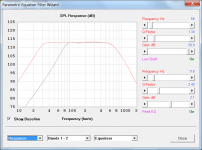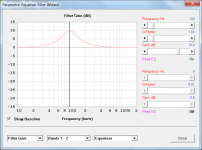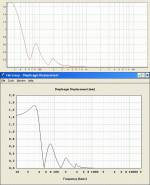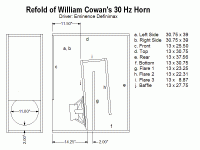Hi Art,
As stated in the Hornresp Help file, behaviour at all input voltage levels is assumed to be linear, with no allowance being made for low frequency high power amplitude compression. It is impossible to take non-linearities into account given the limited set of input parameters used to specify the driver, and the manufacturer is unlikely to provide the necessary additional information - if indeed they have it .
.
In that case, perhaps the Filter Wizard tool should be removed from Hornresp - I only implemented the feature because of ongoing requests from users. As people may recall, I didn't really want to do it anyway. It seems a bit of a shame at this late stage though, given the number of hours expended on the project. Also, I am finding that the development version of the proposed parametric equaliser is quite fun to use... .
.
Kind regards,
David
Hornresp does not take the dropping BL into account, and it appears to consider the suspension to have near infinite elasticity and linearity,
As stated in the Hornresp Help file, behaviour at all input voltage levels is assumed to be linear, with no allowance being made for low frequency high power amplitude compression. It is impossible to take non-linearities into account given the limited set of input parameters used to specify the driver, and the manufacturer is unlikely to provide the necessary additional information - if indeed they have it
This observation is why I am amused by user's delight in your addition of filter models and your consideration of PEQ filters, as the range below Fb is exactly where the simulations will differ most widely from measured results.
In that case, perhaps the Filter Wizard tool should be removed from Hornresp - I only implemented the feature because of ongoing requests from users. As people may recall, I didn't really want to do it anyway. It seems a bit of a shame at this late stage though, given the number of hours expended on the project. Also, I am finding that the development version of the proposed parametric equaliser is quite fun to use...
Kind regards,
David
Attachments
Hi Mark,
Here's the measurement I made, compared to the Hornresp prediction.
What I did was as follows: I attached a Measurement Specialities ACH01 accelerometer to the dust cap of the driver, and fed it through a preamp to my computer. I measured the impulse response using Arta, and postprocessed the impulse response to get the displacement. The post processing was FFT, followed by double integration (divide by (2*pi*f)^2) and a scaling factor determined by the sensitivity of the accelerometer, preamp gain etc., and checked by a reference measurement.
-Bjørn
I should contact Bjørn and find out what he has done so as to not duplicate it.
Here's the measurement I made, compared to the Hornresp prediction.
What I did was as follows: I attached a Measurement Specialities ACH01 accelerometer to the dust cap of the driver, and fed it through a preamp to my computer. I measured the impulse response using Arta, and postprocessed the impulse response to get the displacement. The post processing was FFT, followed by double integration (divide by (2*pi*f)^2) and a scaling factor determined by the sensitivity of the accelerometer, preamp gain etc., and checked by a reference measurement.
-Bjørn
Attachments
Originally Posted by David McBean
perhaps the Filter Wizard tool should be removed from Hornresp
Don't you dare
The EQ is looking good
Regards
the filter wizzard is a verry usefull tool for most of us.Hi Art,
As stated in the Hornresp Help file, behaviour at all input voltage levels is assumed to be linear, with no allowance being made for low frequency high power amplitude compression. It is impossible to take non-linearities into account given the limited set of input parameters used to specify the driver, and the manufacturer is unlikely to provide the necessary additional information - if indeed they have it.
In that case, perhaps the Filter Wizard tool should be removed from Hornresp - I only implemented the feature because of ongoing requests from users. As people may recall, I didn't really want to do it anyway. It seems a bit of a shame at this late stage though, given the number of hours expended on the project. Also, I am finding that the development version of the proposed parametric equaliser is quite fun to use....
Kind regards,
David
like you say,non linearities have to be taken in to account.
Please, keep the Filter Wizard.
Hi David,
I find the Filter Wizard to be a very important addition/improvement of Hornresp. Together w/ the Speaker Wizard it allows Hornresp to provide reasonable simulations of so many enclosures which by design need to have damping and filtering applied to function reasonably, e.g.: some back loaded horn fullrange loudspeakers and transmission lines.
Additionally, you have brought some amusement to Art's life, what more can one ask for.
Best Regards,
Hi David,
I find the Filter Wizard to be a very important addition/improvement of Hornresp. Together w/ the Speaker Wizard it allows Hornresp to provide reasonable simulations of so many enclosures which by design need to have damping and filtering applied to function reasonably, e.g.: some back loaded horn fullrange loudspeakers and transmission lines.
Additionally, you have brought some amusement to Art's life, what more can one ask for.
Best Regards,
In that case, perhaps the Filter Wizard tool should be removed from Hornresp - I only implemented the feature because of ongoing requests from users. As people may recall, I didn't really want to do it anyway. It seems a bit of a shame at this late stage though, given the number of hours expended on the project. Also, I am finding that the development version of the proposed parametric equaliser is quite fun to use....
You evil, evil man!
Playing with new toys and threatening evilness on us!
Like what I'm seeing!
@ Bjørn
Interesting. What was the loading of the driver?
Free air, or some enclosure?
@ Bjørn
Interesting. What was the loading of the driver?
Free air, or some enclosure?
It was measured on a tapped horn, to check if the Hornresp predictions were accurate.
-Bjørn
Additionally, you have brought some amusement to Art's life, what more can one ask for.
What more indeed
Originally Posted by tb46
Additionally, you have brought some amusement to Art's life, what more can one ask for.
Appears we're both easily amused..
Art
Additionally, you have brought some amusement to Art's life, what more can one ask for.
David,What more indeed.
Appears we're both easily amused..
Art
I am currently fiddling around with small frontloaded horn, think LaScala size but with 20 cm extension into the doghouse and a 12" driver. I am trying out different chamber sizes to both shape the shape of the high pass fall as well as the peak cone motion. Is it possible to add two resistrictions to the modelling max cone motion and max power? I can sort of do it by flipping around with voltage that either lead to max watt or max x-max for a given back chamber volume. I might even add a serial cap to that to stir things up 
Is it possible to add two resistrictions to the modelling max cone motion and max power?
Hi DrBoar,
Have you tried using the Maximum SPL tool?
Kind regards,
David
Hornresp and multiple drivers
David,
I'm a new-bee here and tried to find the answer on my question, but could not find it or overlooked (sorry..)
I was trying to model a unity horn with 4 mid drivers. started with one driver, all OK. I used the "bottom" 6 fields of the input window to be specific on how the driver was connected to the horn. Makes a LOT of difference from keeping all the 0,00.
Vrc for the back volume (chamber) of the driver
Lrc As the longest distance in the chamber
Ap1 for the TAP circumference
Lpt as the depth of the TAP (started by entering the wood thickness)
Vtc as the volume between the Cone and the horn
Atc as the circumference of the driver at the point where the driver is connected to the horn.
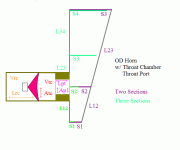
When I got it right for 1 driver (flattest response for the bandpass i needed) i thought (and THAT's the main topic of my question) I use the Tool/Driver arrangement (Ctrl + D) to enter 2 driver parallel and 2 serial to work with 4 drivers.
I assumed that Hornresp does the values x 4 of the parameters above (except for Lpt?) to calculate the new driver arrangement, but the outcome was very unexpected, so APPARENTLY NOT?
1 - Do I have to multiply ALL of the parameters by 4?
2 - I still assume Lpt is always the depth of the port?
Besides these 2 questions, when i want to add Bass reflex ports in the back chamber, do I need to enter the total volume of the 4 drivers? I tested with Bassbox Pro and 4 8 inch drivers, which gave a volume of 20 liters for a port tuned at 105 Hz. When i entered 20 liters as the back chamber volume Vrc, the result was a severe drop in response from 300 Hz downwards.
3 - Did you account for this in Hornresp (larger Vrc then needed for the horn) or is not in the program.
LAST question, on the Eg parameter and multiple drivers.
Suppose i have 1 driver, 100 watts 8 ohms. I enter 28,28 in the Eg parameter for 100 watts, works OK. Now 2 drivers, both 100 watts 8 ohms parallel, makes 200 watt 4 ohms. Normally the amp will go to less than 200 watts at 4 ohms, say 180 watts.
4 - Do I enter 100 watts (28,28) and 2 drivers and does Hornresp account for 180 watts at 4 ohms as delivered by the amp? Or do I enter 37,95 in Eg as 180 watts.
Or do I enter 90 watts (26,83) for the driver, since both drivers now each get 90 watts instead of the one driver 100 watts.?
Again thanks for the clever tool, now it's up to me using my brains (sigh)
kind regards,
Frans Wessels
btw I will start posting when i got most of the flaws away from my side......
David,
I'm a new-bee here and tried to find the answer on my question, but could not find it or overlooked (sorry..)
I was trying to model a unity horn with 4 mid drivers. started with one driver, all OK. I used the "bottom" 6 fields of the input window to be specific on how the driver was connected to the horn. Makes a LOT of difference from keeping all the 0,00.
Vrc for the back volume (chamber) of the driver
Lrc As the longest distance in the chamber
Ap1 for the TAP circumference
Lpt as the depth of the TAP (started by entering the wood thickness)
Vtc as the volume between the Cone and the horn
Atc as the circumference of the driver at the point where the driver is connected to the horn.

When I got it right for 1 driver (flattest response for the bandpass i needed) i thought (and THAT's the main topic of my question) I use the Tool/Driver arrangement (Ctrl + D) to enter 2 driver parallel and 2 serial to work with 4 drivers.
I assumed that Hornresp does the values x 4 of the parameters above (except for Lpt?) to calculate the new driver arrangement, but the outcome was very unexpected, so APPARENTLY NOT?
1 - Do I have to multiply ALL of the parameters by 4?
2 - I still assume Lpt is always the depth of the port?
Besides these 2 questions, when i want to add Bass reflex ports in the back chamber, do I need to enter the total volume of the 4 drivers? I tested with Bassbox Pro and 4 8 inch drivers, which gave a volume of 20 liters for a port tuned at 105 Hz. When i entered 20 liters as the back chamber volume Vrc, the result was a severe drop in response from 300 Hz downwards.
3 - Did you account for this in Hornresp (larger Vrc then needed for the horn) or is not in the program.
LAST question, on the Eg parameter and multiple drivers.
Suppose i have 1 driver, 100 watts 8 ohms. I enter 28,28 in the Eg parameter for 100 watts, works OK. Now 2 drivers, both 100 watts 8 ohms parallel, makes 200 watt 4 ohms. Normally the amp will go to less than 200 watts at 4 ohms, say 180 watts.
4 - Do I enter 100 watts (28,28) and 2 drivers and does Hornresp account for 180 watts at 4 ohms as delivered by the amp? Or do I enter 37,95 in Eg as 180 watts.
Or do I enter 90 watts (26,83) for the driver, since both drivers now each get 90 watts instead of the one driver 100 watts.?
Again thanks for the clever tool, now it's up to me using my brains (sigh)
kind regards,
Frans Wessels
btw I will start posting when i got most of the flaws away from my side......
Last edited:
Hi,
BassBox Pro and Hornresp are the same in that they assume you are putting 4 drivers in the same "box". Hornresp is not aware of your intent to make a horn with 4 separate driver chambers.
WRT the Eg parameter in the design input screen: Hornresp applies voltage to your load, when you are telling it the watts and nominal impedance it is using those values to calculate the applied voltage. This is independ of the actual driver impedance or configuration you may choose.
BassBox Pro and Hornresp are the same in that they assume you are putting 4 drivers in the same "box". Hornresp is not aware of your intent to make a horn with 4 separate driver chambers.
WRT the Eg parameter in the design input screen: Hornresp applies voltage to your load, when you are telling it the watts and nominal impedance it is using those values to calculate the applied voltage. This is independ of the actual driver impedance or configuration you may choose.
Last edited:
Hi Frans,
Further to Dan's comments, and to answer your specific questions:
Multiply Vrc, Ap1, Vtc and Atc by 4.
Leave Lrc and Lpt unchanged.
Vrc is the effective enclosed air volume behind the driver diaphragms. Do not include the volume of the 4 drivers in Vrc.
Did you use the Combined Response tool to calculate the overall system output?
If Eg is 28,28 volts and Rg is zero:
For two drivers connected in parallel, 28,28 volts is applied to each voice coil.
For two drivers connected in series, 14,14 volts is applied to each voice coil.
The actual power delivered by the amplifier will depend on the electrical input impedance of the loudspeaker, which varies with frequency.
Kind regards,
David
Further to Dan's comments, and to answer your specific questions:
1 - Do I have to multiply ALL of the parameters by 4?
Multiply Vrc, Ap1, Vtc and Atc by 4.
2 - I still assume Lpt is always the depth of the port?
Leave Lrc and Lpt unchanged.
3 - Did you account for this in Hornresp (larger Vrc then needed for the horn) or is not in the program.
Vrc is the effective enclosed air volume behind the driver diaphragms. Do not include the volume of the 4 drivers in Vrc.
When i entered 20 liters as the back chamber volume Vrc, the result was a severe drop in response from 300 Hz downwards.
Did you use the Combined Response tool to calculate the overall system output?
4 - Do I enter 100 watts (28,28) and 2 drivers and does Hornresp account for 180 watts at 4 ohms as delivered by the amp?
If Eg is 28,28 volts and Rg is zero:
For two drivers connected in parallel, 28,28 volts is applied to each voice coil.
For two drivers connected in series, 14,14 volts is applied to each voice coil.
The actual power delivered by the amplifier will depend on the electrical input impedance of the loudspeaker, which varies with frequency.
Kind regards,
David
Reply: Hornresp and multiple drivers
David,
Thanks for the quick response, all clear now except for one.
"Did you use the Combined Response tool to calculate the overall system output?"
No, i did NOT use it, i don't know how to use it, so need to figure out. The first time i noticed "Combined response" i thought woooow cool, that's what i need, but it kept "faded" in the menu, so i could not activate it and left sitting there until i have some spare time. I currently use the "OD" horn type.
I have a one-man-business in ICT consultancy to make a living, I play bass in 3 bands and have been a life-time sound engineer, building my own PA and bass cabinets as a hobby. So not much time left. (excuses , excuses..... When i read about the Tapped and Unity horn, i thought, time for an upgrade.
When i read about the Tapped and Unity horn, i thought, time for an upgrade. 
Questions;
1 - What makes the Combined response to to be active?
2 - How is the bass port contribution defined?
3 - Is the OD setting the correct one for a Unity Horn with bass reflex ports?
I use version 34.30
Thanks again,
kind regards,
Frans Wessels
David,
Thanks for the quick response, all clear now except for one.
"Did you use the Combined Response tool to calculate the overall system output?"
No, i did NOT use it, i don't know how to use it, so need to figure out. The first time i noticed "Combined response" i thought woooow cool, that's what i need, but it kept "faded" in the menu, so i could not activate it and left sitting there until i have some spare time. I currently use the "OD" horn type.
I have a one-man-business in ICT consultancy to make a living, I play bass in 3 bands and have been a life-time sound engineer, building my own PA and bass cabinets as a hobby. So not much time left. (excuses , excuses.....
Questions;
1 - What makes the Combined response to to be active?
2 - How is the bass port contribution defined?
3 - Is the OD setting the correct one for a Unity Horn with bass reflex ports?
I use version 34.30
Thanks again,
kind regards,
Frans Wessels
@ wae
Hi, congrats on trying to model a unity hornAre you actually going to build one ? Keep us updated on your progress

Yes, i will certainly try to do so.
I have tested some Tapped horns, like the THAM12 (VERY OK and small to handle, maybe a bit to small for a PA sub) and started my own version which is slightly bigger (longer horn path to make it go deeper (40 Hz) and wider to get enough volume as stated by Hornresp and make it easier to mount the drivers. It will be a different folding as the THAM12 with the driver magnet facing the mouth (so standing up instead of laying down).
Like in the picture added (fold of William Cowan's)
I added reflectors to the THAM12 (to stay close to the Hornresp Schematic) and used a fairly large magnet driver in the THAM12, so most likely i wasted to much volume to make it work. My fault.....
I will post the whole set when the results are what i would like them to be. As of now, it is still designing, building and testing and i guess we have seen enough of that here so i thought "Why would i repeat what has been written over and over". And to be really honest, i don't like to make a fool out of myself more then once on this forum, since there are plenty of guys who REALLY now how it works.
Will be for a couple of weeks before i can post though.
The Unity will be an 60 x 60 degree horn experiment i call "leave out the middle man". It is a 4x 8-inch low mid driver (180 - 1200 Hz +- 3 dB) and 1 1-inch CD (1200 - 20000 Hz). So NO separate mid drivers. I must be able to use cheap(ish) 8 inch (i am testing with Faital Pro 8FE200, since i have them in my shed) and a standard 2-way filter, commercially available and working at 1000 - 1200 Hz to be more kind to the CD. I now use an eminence 2-way filter. First results are promising, but i need a severe cone correction for the 8-inch's to get them play such a wide band-pass. It's do-able i hope
It will be combined with a Tapped Horn (35 - 150 Hz +- 3 dB) as a six fold scheme. Should fit in a passenger vehicle and be scalable from small set (1 corner placed TH and 1 -2 Unity in a pub) to outdoor PA (4 - 8 TH's and 2 - 4 Unities) using Crown digital amps (small, light, enough power and low price).
I figured that the advantage of having high SPL boxes must be used, so 2x Crown XLS 1500 can do the job and are nice value for money. They have a DSP internal, so if i need the set to be very simple i could leave out the DBX PA+, which is my current DSP, nice tool.. Using 2 of them will give 2 Kw into the Horns, will give a nice bang, at least enough for my goal (and most of us?). No chance of burning the drivers in any setting, not even kill the cone as long as the "Low cutoff" is kept at 5 Hz below the excursion dip (using the Filter wizard will help me figure that one out). So that's a comfortable idea..
Bottom line of this setup is that NO component will be stressed while operating, which in my opinion is the golden key to nice sound (enough headroom everywhere).
Mixers are Soundcraft 16 channel (19-inch version) or Mackie 32-8.
kind regards,
Frans Wessels.
Attachments
- Home
- Loudspeakers
- Subwoofers
- Hornresp
